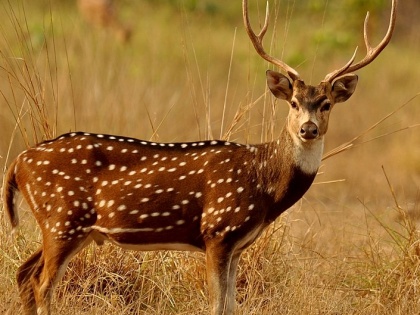First time in Rajasthan, forest department through Boma capturing technique translocated Chitals (spotted deer) from Bharatpur's Keoladeo to Mukundara Hills Tiger Reserve
By Anubha Jain | Updated: March 12, 2022 13:20 IST2022-03-12T13:18:59+5:302022-03-12T13:20:15+5:30
To inhabit leopards and tigers in Mukundara Hills Tiger Reserve, first time in Rajasthan, the forest department of Ghana ...

First time in Rajasthan, forest department through Boma capturing technique translocated Chitals (spotted deer) from Bharatpur's Keoladeo to Mukundara Hills Tiger Reserve
To inhabit leopards and tigers in Mukundara Hills Tiger Reserve, first time in Rajasthan, the forest department of Ghana and Kota with the use of the Boma capturing technique of Madhya Pradesh, successfully translocated the first trials of Chital (spotted deer) from Keoladeo National Park to Mukundara Hills Tiger Reserve on March 9th, 2022. Seeing the increasing number of 3500 to 4000 chitals in Keoladeo National Park, Bharatpur, the park has been chosen to relocate chitals to Mukundara.In the first phase, 6 chitals including 2 male and 4 female chitals have been relocated to Mukundara Tiger Reserve. This entire process was completed under the supervision of Field Director Mukundara Hills Tiger Reserve Sedu Ram Yadav; Mukundara Tiger Reserve’s Deputy Conservator of Forest Bijo joy, and Bharatpur Ghana Keoladeo National Park Deputy Conservator of Forest Mohit Gupta, along with the field team of Keoladeo National Park, Bharatpur. There is a target to relocate 500 chitals from Ghana to Mukundara national park. 450 km. journey was completed in 10 hrs. Tarun Mehra, Assistant Conservator of Forests, Ramgarh Vishdhari Sanctuary, Bundi district stated that to ensure that there is enough prey for tigers and leopards, this step has been initiated. In the absence of adequate prey, the tigers can move out of their natural habitat and hunt domestic animals or local people living in adjoining villages.
Mentioning the technique Mehra said that Boma capturing technique is mainly used in the countries of the East African forests and in India, Madhya Pradesh has also used this technique to relocate animals. In the Boma technique, a closed enclosure or compartment is created. The technique involves the luring of animals into an enclosure by chasing them with food grains and water through funnel-like fencing. On one side of the enclosure chital or any animal is kept with their food and water. For almost a month these chitals are kept in the forest itself inside the enclosure with the arrangement of food and water there. In this technique animals without making them unconscious relocate to different places. Mukundara Tiger Reserve deputy forest conservator R.S.Bhandari said that at the zoo this animals’ relocation is common but for wild animals’ shifting from a wild forest area to another area is an unusual and difficult task. As these animals are fragile and soft-hearted so there is a great chance of their death while conducting such operations. In coming times there is a plan to translocate 750 spotted deer or chitals in Jaipur, Kota, and Karauli. The tigress MT-4 is presently in the soft enclosure of the 28-hectare area. After a huge demand to release MT-4 from the soft enclosure to the open forest of Mukundara, the National Tiger Conservation Authority (NTCA) has granted permission to relocate MT-4 to Mukundara Hills Tiger Reserve. According to the officials of the Mukundara tiger reserve, it is planned that a pre-base will get ready by the forest department to ensure prey for tigress MT-4 and settle the tigress there. With this, there would be only one alive tiger MT-4 in the Reserve. In the coming times, the forest department will try to bring a few more tigers to Mukundara. Earlier, MT-2 and MT-3 died, whereas MT-1 is missing for over a year from the reserve.
Open in app